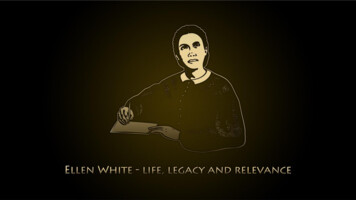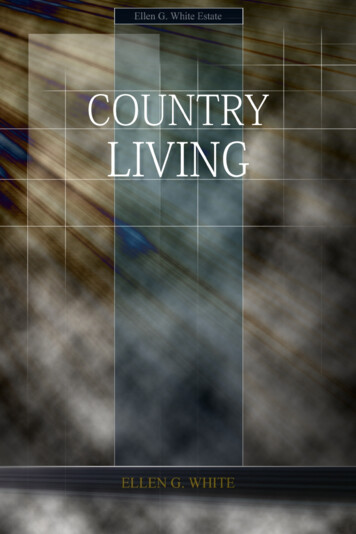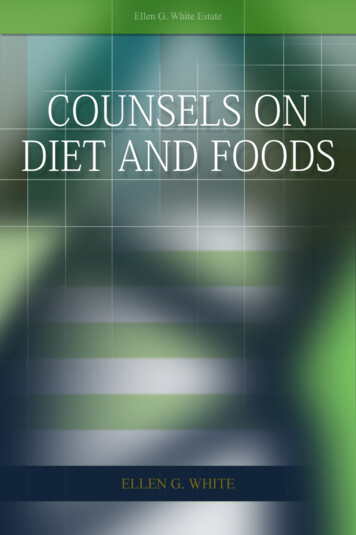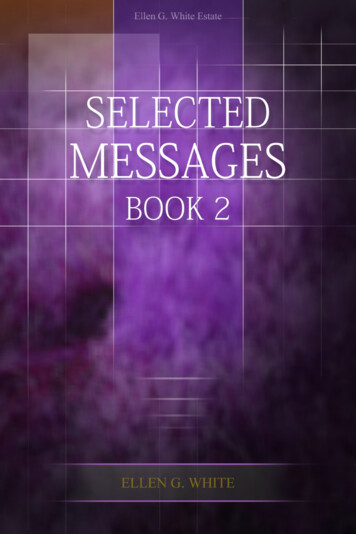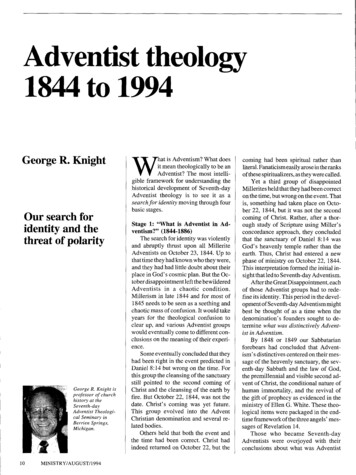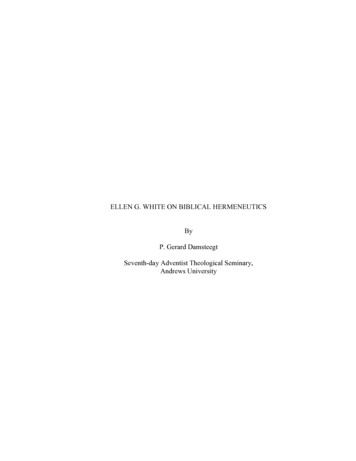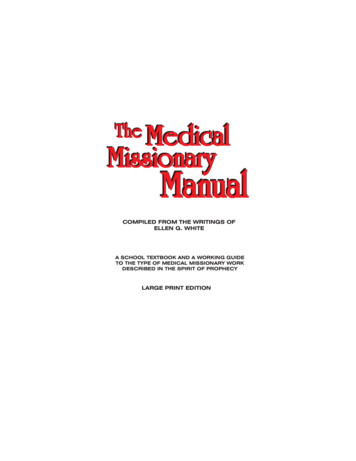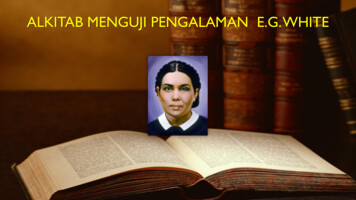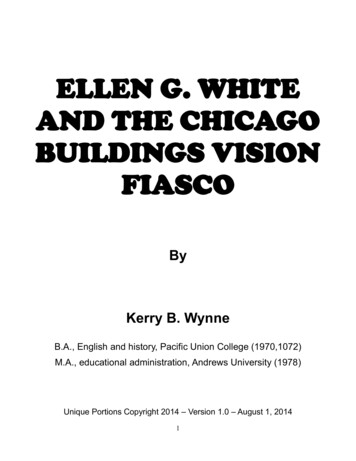
Transcription
ELLEN G. WHITEAND THE CHICAGOBUILDINGS VISIONFIASCOByKerry B. WynneB.A., English and history, Pacific Union College (1970,1072)M.A., educational administration, Andrews University (1978)Unique Portions Copyright 2014 – Version 1.0 – August 1, 20141
THE CHICAGO BUILDINGS VISIONEllen White's Chicago Buildings Vision was her most spectacular prophetic blunder, and the relating of it to Dr. JohnHarvey Kellogg in an official “testimony” [“testimony” understood by all Adventists to mean a communication fromGod through his mouthpiece, Ellen White, to an individual person or group] resulted in her becoming the butt ofjokes among the group of Adventist physicians who had associated themselves with Dr. Kellogg at the Battle CreekSanitarium. Even her Clintonian evasiveness was no match for the giant intelligentsia represented by this group ofdoctors. Their incomes were not dependent on the Seventh-day Adventist Church, so they were able to react tothings as reason and common sense would indicate. She would spend the next three years trying to escape theproblems she created for herself, but her excuses were unconvincing and even comical at times. The fiasco resultedin the unmasking of Ellen White as a false prophet and initiated a series of events that led to the secret 1919 BibleConference meeting that forced the top leaders of Adventism to debate whether to come clean with the Church anddenounce her as a fraud or to continue the cover-up of the truth about her. Additional prophetic blunders betweenthe turn of the century and her death in 1915 virtually forced the delegates of the 1919 Bible Conference to addressthe issue of her fraudulent prophetic claims. For an over-view of the history of these events, please see the 8thEdition of LYING FOR GOD: What Adventists Knew And When They Knew It!Extensive research has made it possible to assemble a time-line of events surrounding the Chicago BuildingsFiasco—a time-line that nails Ellen White to the wall and proves beyond any reasonable doubt that she attemptedto cover her blunder by a series of falsehoods. By trying to create the illusion that God had given her thesupernatural ability to discern what people were doing on the other side of the world, she embarrassed herself andthe Church. In fact, by claiming to speak for God when she clearly did not speak for Him represents a type ofblasphemy. The cover-up of this highly unflattering chapter of Adventist history represents one of several crowningachievements of the damage control expertise of Adventist leadership.Additionally, her demand, made in the name of God, that Dr. Kellogg send her Battle Creek Sanitarium funds forher Australian sanitarium project represented her ascension above the law of the land, since the Sanitarium's newMichigan charter (as of 1897) would have made such an action illegal. She would have to have understood theprovisions of the new charter, since she was a stockholder in the Sanitarium after its reorganization. Would Goddirect her to break a reasonable and just law simply because it was inconvenient to Ellen White’s own personalagenda? Would that be rendering to Caesar?She began to demand money from Kellogg for the new sanitarium in Australia during the year of 1899. Unfortunatelyfor Ellen White, Dr. Kellogg's half-brother, Dr. Merritt G. Kellogg, visited Ellen in her home in Australia in the year1900, just about the time her patience with Dr. Kellogg's Chicago program had run out. Dr. Merritt G. Kellogg's 1908statement testified that he explained to her that it would be illegal for Dr. J. H. Kellogg to send her Battle CreekSanitarium funds because of the new charter. He also testified that she had shown him an American newspaperarticle, several years old, which gave an inaccurate account of what Dr. Kellogg was doing in Chicago. He alsostated that he saw her mail her testimony of rebuke to him three days later.In the summer of 1900, she returned to America from Australia.In the year following her return from Australia, she and her son, Willie C. White, threw their support behind the projectto construct a new building for the American Medical College– the only construction project in the Chicago Area evercontemplated by the Adventist Church and/or the Battle Creek Sanitarium group. She and Willie were present atthe 1901 General Conference session, and they voiced their support for the new building. Willie White attended aspecial board meeting, also convened in 1901, to consider the plans for the new building, and he expressed his totalsupport for its construction. If Ellen White was God's mouthpiece to communicate His will for Adventists, Willie Whitewas many times Ellen White's mouthpiece for communicating her will to her followers.The Battle Creek doctors and most everyone else at the Sanitarium were trying to figure out if she had condemned,in her testimony to Dr. Kellogg in 1899, the construction of the same building that she and her son heartily approvedjust two years earlier. This comic element confronts anyone who takes the time to learn the facts.2
Charles E. Stewart, in his account of the fiasco, reported that even the members of the committee responsible forplanning the new American Medical College building in Chicago kept right on planning for it because it didn't dawnon them for a moment that she could possibly be condemning them for the planning they were doing. In their minds,she had to be talking about some other building.Even beyond this is the fact that Ellen White had become a stock-holder in the Sanitarium ever since its reorganization under the new charter in 1897, raising the question of a conflict of interest issue. Did she not want Dr.Kellogg spending the Battle Creek Sanitarium's money in Chicago because she wanted her shares to pay higherdividends?For Ellen White, it is sad that she had to bring all of this trouble on herself. If she had left the supernatural claimsout, things might not have been so bad for her. She could have written to Kellogg and said something like, “Harvey.I have just read a report about your extravagant spending in Chicago on the unworthy poor, and I don't think that it'swhat God wants you to do with your money. I believe God wants you to spend your money where it can do the mostto keep the unique doctrines of Adventism at the forefront.” By crediting God for her information, she made it looklike God hadn't looked in on things at Battle Creek or Chicago for a long time, or that He had forgotten what He hadseen when He was there. This lying about the source of her information smacks of being a kind of “White collar”blasphemy. However, we could not exactly say that everything would have been okay for her had she not had theChicago Buildings Vision.Over the years prior to the fallout from the Chicago Buildings Vision, Ellen White had committed a series of nearlyequal blunders that had already pushed her credibility with the Battle Creek physicians to the limit. She hadcontradicted herself in her “testimonies” so many times that the doctors were confused and asking for answers.They were puzzled that she continued to eat meat, and even unclean meats like oysters, while she had preached astrict vegetarian diet. They were amused that in the later years of Ellen's ministry it was the influence of a Catholicwoman that finally convinced her to stop eating meat because it was cruel to animals.They were baffled by her bizarre and contradictory statements about the use of medications, and they had caughther in outlandish plagiarism in the case of the British book, Sketches from the Life of Paul. They were not amusedto discover, as widely-read professionals, that she had copied the health teachings of a certain Dr. Cole and claimedthat the information she got from him came from God in vision. Perhaps they knew that Ellen's teaching against theuse of Quinine was responsible for killing many of the earliest Adventist missionaries. When these missionariescame down with Malaria, they would not administer this life-saving drug to themselves or to their children. (SeeAppendix VII for documentation.)Additionally, many of the players in the Battle Creek drama were aware of the fact that her testimonies were oftenthe result of human influences. The case of A. R. Henry is one such example.According to the White Estate, A. R. Henry was a Battle Creek banker who became a Seventh-day Adventist. In1882 he was invited to join the administrative staff of the Review and Herald Publishing House. In 1895-1896 EllenWhite, who was then in Australia, began to worry about what she perceived as the secularizing influence of A. R.Henry and another SDA businessman, Harmon Lindsay, who was treasurer of the General Conference, which wasthen headquartered in Battle Creek. According to the White Estate, she began sending testimonies to key GeneralConference leaders– and in particular to O. A. Olson, the president of the General Conference. As a result of thesetestimonies, both A. R. Henry and Harmon Lindsay lost their denominational positions. (Reference: Dissidents,Within and Without, Chapter 21, posted ml)Here is what the White Estate says about this situation:Although Ellen White’s sympathies were with Elder Olsen, she did not spare words: “Ifelt that you were being bound hand and foot, and were tamely submitting to it.” BecauseGod was illuminating her mind, she saw what others could not see clearly: “Things are3
being swayed in wrong lines.” She saw, behind the surface reasonings, that leading menwere acting “as though they were in God’s place, . . . deal[ing] with their fellow men as ifthey were machines. I cannot respect their wisdom or have faith in their Christianity.”Then, writing specifically: “The Lord has presented to me his [Henry’s] dangers. I expectnothing else but he will say, as he has always done, ‘Somebody has been telling SisterWhite.’ This shows that he has no faith in my mission or testimony, and yet Brother Olsenhas made him his right-hand man.” (Letter 59, 1895, cited in Bio., vol. 4, p . 255.)From what we know of the Battle Creek fiasco, it is not surprising that A. R. Henry would have little faith in theTestimonies. Questions about her prophetic gift were surfacing everywhere as a result of her various blunders.Whatever, with her words she placed him in a class of individuals who act as though they were in God's place andwho deal with their fellow men as if they were machines. Henry lost his denominational job over these accusations.When Henry's lawyer began approaching the Church about the matter, an internal investigation began to find outhow Ellen White got the information about A. R. Henry in the first place. As they scrambled to find out how theywere going to defend themselves in the anticipated law suit, here is Dr. J.H. Kellogg's account of what happened.Kellogg was the CEO of the Battle Creek Sanitarium, as you will recall:Evans said, "This thing ought to be stopped, anyhow – these testimonies here." He said,"If there were just enough of us to stand together on it, I believe we could stop that thing."He said, "Will White doesn't believe those testimonies." He said, "Now I will just tell youhow I know."He said, "You know A. R. Henry was suing us for libel here, and you remember about thatMr. Hulbert was our attorney. And I was down to Mr. Hulbert's office one day, and hesaid, 'Look here, where did Mrs. White get that information about Mr. A. R. Henry?'"Henry [had] charged that the things written about him [in the testimony] were not true.Now I want to tell you a little word about that thing. I know how that Henry testimonywas manufactured. A. O. Tait in the office came to me, and he said, "We are going to dothe old man up." He said, "I am writing letters to Sister White, and I am getting lettersfrom her, and I am writing her, and we are going to do the old man up. And we are goingto get him out of that, and we won't have that man there." Pretty soon A. O. Tait came tome, and he said he had got a letter from Sister White, ousting the old man. He had beenwiring and writing her the information, and he told me he was going to do it in addition.Mr. Hulbert asked Mr. I. H. Evans, "Evans, how does Mrs. White get this information?"Evans said, "Why, I said to him, 'I am not much acquainted with Mrs. White. I never mether but once. But my understanding is that she is a prophet and that the Lord gives herthis information in visions in the night; she has visions as the old prophets did.'" Evanssaid Mr. Hulbert said, "Oh, fudge, you don't want me to believe such nonsense as that."He said, "That is what I was always led to believe." And he said, "W. C. White, her son,is in town, and I think you better ask him about it."You see, Will's idea was that he was going to save his mother from the charge of libel byshowing where she got the information and get it back onto me and A. O. Tait and theother folks. I hadn't written her any information about Henry at all because I was kind ofsorry for the old man, and my sympathies were rather with him. That would not relieveher at all, but Will did not know the law. He was such a saphead on things of that kind hedidn't know any better than to think that would relieve her by putting it off on these men.So he said, "My mother is in constant correspondence, and she received the information4
from various ones."So Hulbert wrote a letter to Will White, asking him that same question, and he handed itto Evans and Evans looked it over, then put it in an envelope and sealed it up and deliveredit to W. C. White. He was in his office when he delivered it, and W. C. White took itupstairs with him and came down pretty soon. And Evans said, "W. C. White handed methe letter and I looked it over, and this letter read, 'My mother is in constantcorrespondence with the leading members of the denomination, with O. A. Olsen, Dr. J.H. Kellogg, A. O. Tait, W. O. Palmer and various other persons; and she has received herinformation from them.'"Evans said, "I drew my pencil right across the letter clear down to the bottom and leftnothing but the signature, 'Yours truly, W. C. White.' Will said, 'What did you do that for?'I said to him, 'You are giving away the whole case.' "Well,' Will said, 'what else should Isay?'" He said, "You should say, 'My mother is a prophet of the Lord. The Lord comesto her in the visions of the night and has revealed to her these things with reference to A.H. Henry." Evans said to me, "What do you think Will replied? Will White said, 'I cannotlie!'Now there was that testimony over which so much fuss was made by A. R. Henry, andthere were the actual facts about it that Will White himself testified that the things in thattestimony were written to his mother by A. O. Tait and by other persons and that A. R.Henry was condemned unmercifully for what was not true. And that enormous hullabaloowas made about it, that he was resisting the Lord. That is according to W. C. White's owntestimony.Now, I am going to tell you some more about that thing.B: Willie told me something about it.K: I knew it all the time, you see.B: He told me that what Sister White saw was not with regard to his robbing the institutionor anything of the kind but with regard to withholding means from the Lord.K: There were a whole lot of things in it that were not true at all but just gossip thesepeople had sent. Henry knew it, and Brother Olsen knew it. The thing came in bad shapeon Henry because when these men wrote to her, she sent her testimony back to them, sentcopies to Tait and Palmer and sent a copy to O. A. Olsen. And Olsen was to take it andread it to Henry and not to give it to him but to read it to him. And Olsen saw what hehad got to meet, you know, for he knew Henry would know right away just where thatthing came from because it concerned things that he had had trouble with with A. O. Taitand others, and there were personal things in it, and he knew Henry would trace it rightback to the people it came from.Olsen did not dare to meet him with it, and he carried it in his pocket for three weeks. Inthe meantime Tait and Palmer let it out to the boys around the office. So after while it gotaround to A. R. Henry through the boys, and then the fat was in the fire.Source for the above quote: www.ex-sda.com, Transcript, “Interview atDr. J. H. Kellogg's House, October 7, 1907 Between George W. Amadon,Elder a. C. Bordeau, and Dr. J. H. Kellogg, pp. 55-57. (Interview transcriptnotarized by Lycurgus McCoy, December, 1907.See also the paper, “Mrs. White Vs. The Facts: A Paper Submitted in5
Partial Fulfillment of the Course THST 616, Doctrine of Revelation andInspiration,” pp. 9-10; by Aage Rendalen, Andrews University TheologicalSeminary, February 1979.As we mentioned earlier, Ron Graybill, former associate secretary of the White Estate, stated in his leaked doctoraldissertation that Church leaders often manipulated her for their own benefit, while at other times she manipulatedthem to get what she wanted. The A. R. Henry situation is a good example of how SDA leaders manipulated her toachieve their own personal agendas.The doctors asked her to answer questions related to their concerns, but her reaction to their inquiries was as crazyas the things they were asking her to explain. At first she had a vision “from God” instructing her to answer all oftheir questions. After she received their questions she had another vision instructing her not to answer them. Thedoctors, unlike the Adventist clergy, were not dependent on the Church to feed their families, so they were muchfreer than any other class of people to think for themselves and act accordingly.Dr. J. H. Kellogg remained a faithful Sabbath-keeper until he died. However, Dr. William Sadler became the cultleader of the Urantia Movement, which investigated the claims of Spiritualism and taught that spiritual truths can bechanneled by supernatural beings through sleeping human mediums. In the book, Urantia: The Great Cult Mystery(Martin Gardner, Prometheus Books, 1995), a book published first in 1955 under the direction of Dr. William Sadler,the author describes the Urantia Book as “the largest work ever said to have been channeled by super-beingsthrough human contactees. It differs from earlier channeled “bibles” in that it contains a vast amount of modernscience as well as a detailed biography of Jesus Christ, complete with facts not found in the Gospels.” Dr. WilfredCuster Kellogg, a Battle Creek businessman and relative of Dr. John Harvey Kellogg, is described by Gardner asone of the two men most responsible for the bringing forth of the Urantia Book. Gardner says, “Both began tochallenge the “testimonies” of Sister Ellen White, whereas once they had believed that her books and preachingswere divinely inspired.”The blunder of the Chicago Buildings vision was unequivocal and proved beyond any possible doubt that her prophetic claims were false. Your authors have sought to prove this to the point of over-kill with the presentation of ourresearch.The position of Seventh-day Adventist apologists is that God gave Ellen White a vision of the building or buildings,but did not provide her with much detail about what the vision meant. Therefore, the interpretation of the vision washers– not God's– and, therefore, her error is within normal limits for a prophet who is not quoting God. She is notparticularly at fault for not getting things quite right because God didn't give her any additional information, leavingit up to her to interpret the meaning. Her apologists argue that Dr. Kellogg was planning to put up such a building,or buildings, and that the vision had its desired effect– preventing said construction. This rationalization makes nosense, however, because it is not at all clear which building she was talking about.As you will see when reading the various accounts of the incident provided by different witnesses, Ellen and her son,Willie C. White, were in favor of constructing a building to house the American Medical Missionary College in Chicago.This planning is apparent from the records we provide referencing her attendance at the General Conferencesession of 1901 and a key board meeting which records a statement of Willie C. White in that meeting attesting tohis total support for the project. As Dr. Kellogg stated, the records prove that he never contemplated building anyother kind of a building. He rented or purchased older buildings for his Chicago medical missionary work. TheGeneral Conference session and the board planning meeting came well after her testimony was sent to Kellogg in1899. Just check out the time-line provided in subsequent pages.Over 100 years have passed since the Chicago Buildings Fiasco took place, and all we have are written accountsof what happened. Researchers have to make allowance for possible bias of witnesses. We have good reason tobelieve that Ellen White had ulterior motives for discrediting Dr. J. H. Kellogg. However, we must also be concerned6
that he and his half-brother, Merritt G. Kellogg, may have been subconsciously retaliating for the humiliation that Dr.John Harvey Kellogg experienced as a result of her public rebuke. However, Dr. Merritt G. Kellogg was anupstanding Adventist and medical missionary with a good reputation in the Church. There is nothing in his servicerecord in the Adventist community, prior to his involvement with the fiasco that would suggest that he was not anhonorable Christian gentleman.Ellen White's failure to get some key details right wreaked havoc in the lives of these Church leaders and causedGod to look bad, since she made it appear that God had shown her something that wasn't true. Her apologists liketo compare her receiving a vision that she didn't understand with one that the prophet, Daniel, received, but did notunderstand. Unfortunately, this is a poor example, since the lack of understanding did not cause Daniel to make Godlook bad or to make a fool of himself, and God sent an angel to help him understand the dream when he requestedsuch explanation.Kellogg stated that his rebuke came in the form of a “testimony,” and neither Ellen nor Willie White ever sought todeny that the rebuke did not come in the form of a “testimony.” A “testimony” is a term used by Ellen White andunderstood by Adventists to mean that the content of the message was directly from God. We do not have to takeKellogg for his word in regard to the status of the rebuke he received from Ellen being in the form of a testimony;since neither Ellen White nor her son, Willie White, ever tried to deny that the letter was not a “testimony.” Moreimportantly, we have the word of a Seventh-day Adventist denominational leader and Church historian who workedfor Dr. Kellogg during the later years of Dr. Kellogg's life who states that Dr. Kellogg personally showed him the letterand many others– Alonzo H. Baker. Here is what Baker said in an article he published in the autumn edition ofSpectrum in 1972:In the nearly three years I was with Kellogg, the total time he spent talking of the sequenceof events (from the 1880’s down to 1907) which led to “the break” surely reached the1,000-hour mark. And he had documentation for some of his assertions. For example,the resolution of expulsion from the church has no reference whatsoever to the allegedheresy of pantheism. He showed me copies of letters from church officials in Battle Creekand Mrs. White in Australia, telling Mrs. White that he had “purchased large buildings”in downtown Chicago and was planning to start another Battle Creek Sanitarium there,whereas the truth was that he had leased a building in Chicago for the purpose of housing,feeding and giving medical care to, plus providing evangelism for, some of the very poorin Chicago’s slums; chronic alcoholics, prostitutes, and “slum bums” in general.Ellen wrote letters to friends and family that were intended to be received as “ordinary.” Since Ellen rebuked Kelloggin a testimony, we must hold her to a very high prophetic standard. A source closely associated with the WhiteEstate has informed me that the particular letter Kellogg is referring to is probably not available from the White Estate.However, several letters have been made available to us indirectly from the White Estate from someone closelyconnected with it.The extensive resources provided in the remainder of this chapter provide abundant evidence that demonstratesthat Ellen's testimony to Kellogg was inappropriate, in error, and comical when the entire context of the story isrevealed via a time-line of events. Here is a partial list of her errors:1. She rebuked Dr. Kellogg in the form of an official testimony. Note: We have not been able to obtain acopy of the testimony itself. However, none of the witnesses, including Ellen White herself, deny that shesaid this in the form of a testimony, and we have an affidavit from a well-respected SDA historian that hehad seen this very testimony with his own eyes.7
1. The funds for these buildings came or would come from Battle Creek Sanitarium funds. (The fundswere to come from a building owned by Battle Creek College– a separate entity from the Sanitarium– andfrom the anticipated sale of a particular College property.)2. Dr. Kellogg had planned to erect the building(s) in question. (Dr. Kellogg was in Europe while thebuilding that was to be constructed with funds from the sale of the College property and knew nothing aboutthese plans until he returned from Europe.)3. Ellen White claimed direct authority from God in her demand that the profits from the Battle CreekSanitarium intended for the Chicago buildings be sent to the Work in Australia. The charter of theSanitarium was drawn up such that all of its monies must be utilized within the borders of the State ofMichigan. God would not direct Ellen to do something that was contrary to the laws of the State of Michigan.Jesus taught the “Render to Caesar” concept. Ellen White embarrasses God by making it look like He hadforgotten about the provisions of the Sanitarium's charter. Furthermore, it is reasonable to think that sheknew about the constraints of the charter and knowingly asked Kellogg to do something she knew was notright. From the testimony of Dr. Charles Stewart and the records of the General Conference we know thatEllen White owned stock in the company Dr. Kellogg had organized to manage his health care operations.Today this kind of arrangement would be considered a conflict of interest.4. The Chicago building(s) had been built. - No buildings were EVER built. The ones used in Dr. Kellogg'sextensive Chicago ministry were always rented.Even aside from the issue of whether or not the buildings Ellen White “saw” in vision were or were not built, we havetwo other prophetic blunders that prove she was a false prophet. First, she claimed that God showed her that hehad diverted funds, which he had not done. Second, she ordered him to act contrary to the provisions of the Sanitarium's charter, which was the same thing as commanding him to break the laws of the State of Michigan. To makethis even worse, she knew the provisions of the charter before she mailed her testimony to Dr. J. H. Kellogg sinceKellogg's half-brother, Merit C. Kellogg, had explained the restrictions of the Sanitarium's charter to her before shemailed the letter from Australia. Additionally she was a stockholder in the Sanitarium corporation, and we know fromthe records of their extensive correspondence with each other over the years prior to and during the fiasco that Dr.J. H. Kellogg kept Ellen well-informed about his activities in Chicago.CREDIBILITY OF THE WITNESSESELLEN WHITE – Even back in 1866, three years after the official organization of the Seventh-day Adventist Church,Snook and Brinkerhoff provided ample evidence that she lied about how long she espoused the Doctrine of the ShutDoor. During the 1970’s, Skip Baker's photographing and publication of an 1847 letter of hers (See historical timeline for 1980) to Joseph Bates provided unequivocal proof that Snook and Brinkerhoff were right in their accusationthat she covered the matter up and believed in the Shut Door for much longer than she had claimed. She has along string of failed prophecies and other blunders that led to the secret meeting of top SDA officials in 1919 todecide what do about her fraudulent claims. Her contemporaries recorded her orchestrated effort to curtail Dr.Kellogg’s power, and her successful attempt to squelch the publication of Kellogg’s book on healthful living, TheLiving Temple, because it would have competed for sales with a book she was planning to publish on the samesubject. We have a smoking-gun motive to explain her treatment of Kellogg. She lied about the duration of her beliefin the Shut Door Doctrine. It doesn't seem reasonable to trust her to tell the full truth about things when she is in abind.DR. CHARLES STEWART - This friend of Dr. John Harvey Kellogg and contemporary of Ellen White may havebeen biased in his favor, but he was also a devoted, but questioning follower of Ellen. As a background to theChicago Buildings Fiasco, Dr. Stewart had been confronted over the last decade or more with many evidences that8
Ellen White was a fraud. He began asking Ellen for answers, but she never gave him the courtesy of a reply. Finallyshe invited all those who had questions about her gift to put their questions in writing and send them to her. Stewartpresented a set of questions to her in the form of a lengthy letter, but she didn’t bother to respond. This perturbedhim, so he put the letter into booklet form entitled, A Response to an Urgent Testimony from Mrs. E. G. White,and published it. Ellen still never answered any of his questions. In fact she claimed that she had a vision from Goddirecting her not to answer the questions that had been posed to her, although before he submitted these questionsto her she ha
Aug 01, 2014 · for Ellen White, Dr. Kellogg's half-brother, Dr. Merritt G. Kellogg, visited Ellen in her home in Australia in the year . strict vegetarian diet. They were amused that in the later years of Ellen's ministry it was the influence of a Catholic woman that finally convinced
